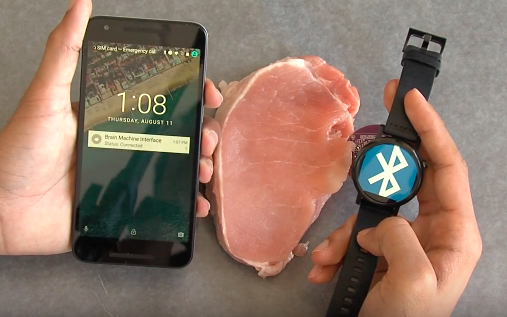
[Image above] University of Washington researchers have a new channel of communication that allows devices like brain implants, contact lenses, credit cards, and even smaller wearables to talk directly to devices like smartphones and watches. Credit: University of Washington Computer Science and Engineering; YouTube
Every day we’re hurtling closer toward a totally cord-free, seamless technological world. Our devices are getting smarter, smaller, thinner, and can do more for us than ever before.
From transparent wearable displays that are “thin as skin” to sand-sized sensors capable of monitoring our bodies’ physiological processes, effective communication of information is a key component of what makes these innovative devices so efficient.
In fact, researchers from the King Abdullah University of Science and Technology in Saudi Arabia recently harnessed white light from lasers to boost data communication speeds of up to 2 GB/s—an innovation that could offer a way to combine information transmission with illumination and display technologies (meaning that someday it might be possible for the ceiling lights in our offices to provide internet connections to our laptops).
Now University of Washington researchers have a new channel of communication that allows devices like brain implants, contact lenses, credit cards, and even smaller wearables to talk directly to devices like smartphones and watches, according to a recent UW Today article.
Credit: University of Washington Computer Science and Engineering; YouTube
Called interscatter communication, the process works by converting Bluetooth signals into wi-fi transmissions. “Using only reflections, an interscatter device—like a smart contact lens—converts Bluetooth signals from a smartwatch, for example, into wi-fi transmissions that can be picked up by a smartphone,” the article explains.
“Instead of generating wi-fi signals on your own, our technology creates wi-fi by using Bluetooth transmissions from nearby mobile devices such as smartwatches,” co-author Vamsi Talla, a recent UW doctoral graduate in electrical engineering who is now a research associate in the Department of Computer Science and Engineering, explains in the article.
And the team says this technology doesn’t require special equipment—it only needs mobile devices commonly found with users to generate wi-fi signals. Plus, the process is significantly more energy efficient, using 10,000 times less energy than current technology.
“Preserving battery life is very important in implanted medical devices, since replacing the battery in a pacemaker or brain stimulator requires surgery and puts patients at potential risk from those complications,” says co-author Joshua Smith, associate professor of electrical engineering and of computer science and engineering at UW. “Interscatter can enable wi-fi for these implanted devices while consuming only tens of microwatts of power.”
This technology opens possibilities for novel device-to-device communication, like enabling a smart contact lens to use Bluetooth signals from a watch to send data to a smartphone app—or an implantable brain interface that can communicate via a Bluetooth headset and smartphone in real-time, or credit cards that can transmit data by backscattering Bluetooth transmissions from a phone, the article explains.
“Providing the ability for these everyday objects like credit cards—in addition to implanted devices—to communicate with mobile devices can unleash the power of ubiquitous connectivity,” says lead faculty Shyam Gollakota, assistant professor of computer science and engineering at UW.
To learn more, check out the open-access paper, “Inter-technology backscatter: Towards internet connectivity for implanted devices,” that was presented August 22 at the annual conference of the Association for Computing Machinery’s Special Interest Group on Data Communication in Brazil.
